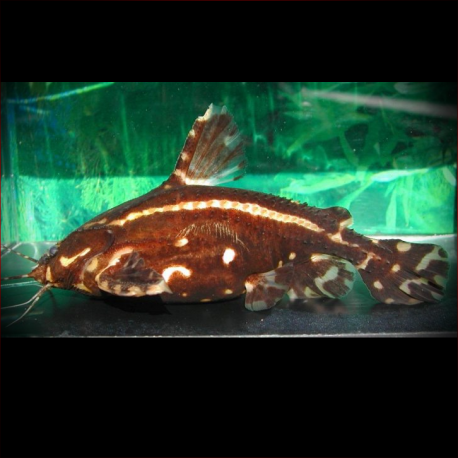More info
Datasheet
| Minimum Tank Size | 115 litres / 30.38 US gallons |
| Maximum Size | 13.7cm / 5.39inches |
| Temperature | 22°C / 71.60°F - 26°C / 78.80°F |
| Hardness | 4.03dgH / 72ppm - 25.04dgH / 447ppm |
| pH | 6.0-7.5 |
General Description
The Acanthodoras spinosissimus, also known as the Chocolate Talking Catfish, is a species belonging to the order Siluriformes in the family Doradidae. These catfish are characterized by their unique infranuchal scute and are often referred to as "talking catfishes" due to their ability to produce audible sounds through specialized mechanisms. They are nocturnal and prefer dimly-lit aquarium environments with sandy substrate and ample hiding spots.
Aquarium Setup
To best care for the Chocolate Talking Catfish, it is recommended to maintain them in a dimly-lit tank with soft, sandy substrate and plenty of cover such as aquatic plants, driftwood tangles, or artificial caves. Bright lighting should be avoided as these catfish are primarily active during the night. The optimal water conditions for them include a pH range of 6.0-7.5, hardness between 72-447ppm, and a temperature of 22-26°C.
Behaviour
Although non-aggressive, adult Chocolate Talking Catfish may prey on very small fish. They thrive in medium-to-large community tanks with other peaceful Amazonian species like characins, cichlids, and other catfish. These catfish are gregarious by nature, so it is recommended to keep them in groups of at least four individuals. They also tend to group together with similar-looking relatives such as Platydoras armatulus, Agamyxis pectinifrons, and Amblydoras hancockii.
Feeding and Diet
The Chocolate Talking Catfish is an omnivorous species that readily accepts various prepared and frozen foods. A balanced diet should consist of high-quality dried sinking pellets or tablets supplemented with live or frozen foods like bloodworms, Tubifex, and mosquito larvae. Occasional earthworms can be offered to provide additional protein to their diet.
Reproduction & Dimorphism
Limited information is available on the reproduction of Acanthodoras spinosissimus. Reports suggest that their close relative, A. cataphractus, forms pair bonds. Both males and females are believed to be involved in excavating a shallow pit for egg deposition, followed by post-spawning care and defense. Mature females typically exhibit a fuller body shape compared to males.
Habitat and Distribution
The Chocolate Talking Catfish is native to slow-moving and standing waters in the Amazon basin, including tributaries, backwaters, freshwater swamps, and coastal mangroves. They are commonly found sheltering among roots or submerged vegetation during the day, emerging at night to forage. Their distribution extends across Peru, Colombia, Brazil, and the Río Essequibo drainage in Guyana.

